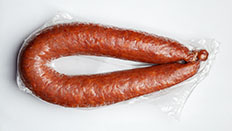Meats and Sausages
Extrawurst
Extrawurst has been produced since 1820 and is one of the most popular sausages in Austria. The sausage is made of beef and/or pork and stuffed into beef casings. Extrawurst is smoked then cooked in water. Friederich Schlögt in his book “The Season of the Sausage” (Der Saison der Wurst - published in Vienna in 1881) states that between 1820-1830 there were eight popular sausages in Vienna: Selchwürstel, Cervelade, Extrawurst, Bratwurst, Leberwurst, Blutwurst (Blunzen), Augsburger and Preßwurst.
| Materials | Metric | US |
|---|---|---|
| First grade lean beef or pork | 450 g | 0.99 lb |
| Pork belly, fat trimmings | 230 g | 0.50 lb |
| Water | 320 ml | 10.6 oz fl |
Ingredients per 1000g (1 kg) of materials
| Salt | 12 g | 2 tsp |
| Cure #1 | 2.0 g | 1/3 tsp |
| White pepper | 1.0 g | 1/2 tsp |
| Nutmeg | 0.5 g | 1/4 tsp |
| Mace | 0.5 g | 1/4 tsp |
| Paprika | 1.0 g | 1/2 tsp |
| Mustard seed, ground | 0.5 g | 1/4 tsp |
| Garlic, smashed | 3.0 g | 1 clove |
| Potato starch | 10 g | 1 Tbsp |
Instructions
- Grind meat and fat through 5 mm (1/4”) plate.
- Using food processor emulsify ground meat, fat, water and all ingredients together until fine paste is obtained.
- Stuff sausages into 55-60 mm pork or beef middles. Extrawurst is stuffed into straight sections or rings (horseshoe shape).
- Hang sausages in smokehouse (no smoke applied) at 48-50° C (118-120° F) until they feel dry to touch.
- Apply smoke at 60° C (140° F) for 60 minutes.
- Cook sausages in water at 75-78° C (167-172° F) until they reach 70° C (158° F) internal temperature. This should take around 60-90 minutes, depending on diameter of the sausage.
- Refrigerate.
Notes
Extrawurst is sliced and consumed cold.


















